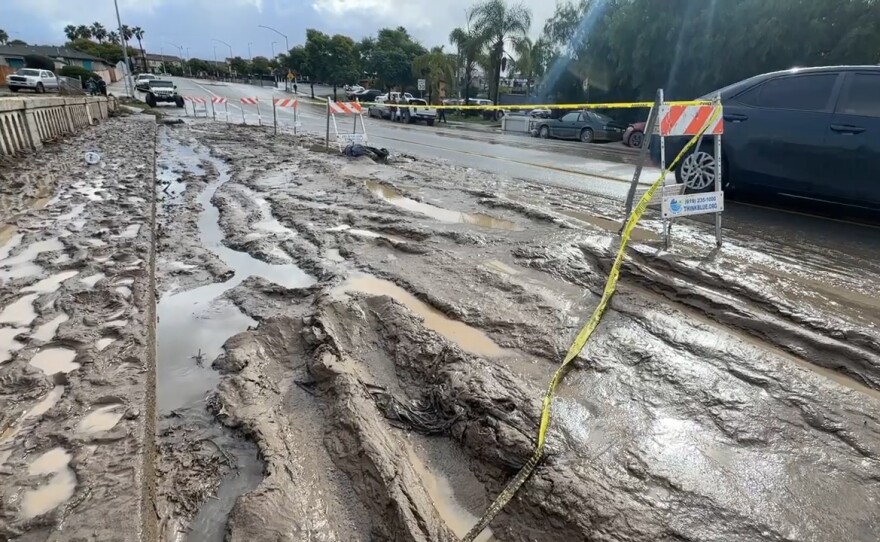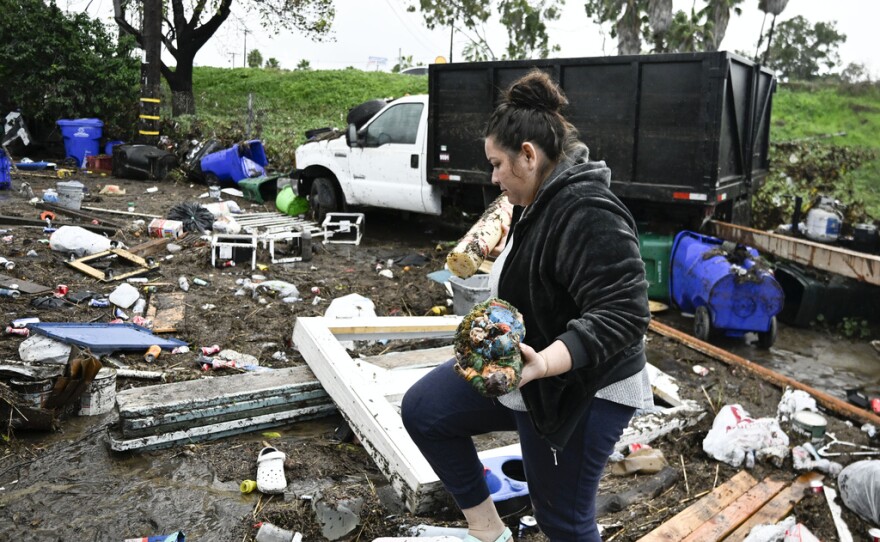- San Diego County damage assessment survey
- San Diego Get It Done app - report clogged storm drains
- Tips for documenting damage for insurance claims
- Info on SDGE bill assistance
- Check a contractor license
- File a price gouging complaint
- Info for renters
- Legal aid
- General flood preparedness info
- San Diego County disaster preparedness app
- Dumpster Drop-Off and Community Cleanup
- Donate to flood victims
- County assistance center for flood victims
- Free vehicle removal and recycling for residents of unincorporated areas of San Diego County
- EPA advice on septic systems after floods
- Where to get free sand bags
- City of San Diego inclement shelter program
- Application for Emergency Response Grant for Small Businesses and Nonprofits
- FEMA assistance
- Info about FEMA Disaster Recovery Centers
Hundreds of San Diegans are assessing the damage caused by Monday's flash floods, which washed away cars, caused a sinkhole in Miramar and blanketed homes and streets in Southcrest with mud and debris.
The intense rainfall in the span of just a few hours laid bare the longstanding inadequacies of San Diego's stormwater infrastructure. And it provided a glimpse into the future, when climate change is likely to hit low-income communities of color the hardest.
For decades, politicians and bureaucrats have swept the stormwater problem under the rug. Major storms are still relatively rare, and surface-level infrastructure needs like potholes tend to draw the most attention from constituents.
The result is a staggering $1.6 billion in unfunded needs for the stormwater system. That deficit has more than doubled in the past five years. It's now larger than the unfunded needs of the city's roads, sidewalks and streetlights combined.
But as San Diego tries to prepare itself for more extreme and unpredictable weather, the recent floods could force the city to finally make long-term fixes to its network of stormwater channels a top priority.

What are stormwater channels?
A stormwater channel is a fancy urban planning term for a river or stream. Some are lined in concrete while others are more natural looking and full of vegetation. They can be exposed to daylight or run underground in tunnels.
Many of San Diego's underground channels were built more than 50 years ago and have reached the end of their useful life. The city's Stormwater Department is trying to replace or repair them proactively and does regular inspections to see which ones have the most urgent needs.
But the stormwater system is so vast that officials don't always know which parts are the closest to collapse. The Stormwater Department also doesn't have enough staff or funding to inspect and fix all the channels in a timely manner.
That means often, underground channels fall apart unexpectedly and the city has to do emergency repairs — like they're currently doing on Miramar Road. Those are more expensive, and they require diverting resources from proactive repair projects, which have to wait longer to get funding. This is why the backlog of repairs has gotten so much worse in recent years.

Why are stormwater channels so hard to fix?
Repairing underground stormwater channels requires digging with heavy machinery — and doing so carefully to avoid damaging water, sewer and electrical infrastructure. These projects require a high level of skill and expertise, so the city has to offer competitive wages to recruit the laborers and engineers who can get the job done safely.
The channels that are exposed to daylight are difficult to maintain for different reasons. These are often naturally occurring creeks and streams and provide habitat for native species. If the city wants to clear them out so water can flow through more quickly, it needs permits from outside agencies, such as the California Department of Fish and Wildlife and the Army Corps of Engineers.
Securing those permits takes years. Sometimes permits require the city to purchase land elsewhere and relocate the vegetation they remove from the channel to ensure there is no net loss of native habitat.
Todd Snyder, director of the city's Stormwater Department, told reporters in a press conference on Tuesday that San Diego has about 200 segments of flood control channels and the resources to do maintenance on about four of them each year.
"We prioritize those channels and maintain the ones that we can," Snyder said. "But a lot of things have to align in order for that to happen."

Why doesn't the city spend more on stormwater infrastructure?
San Diego could increase funding for stormwater channel maintenance — but doing so would require taking money away from other infrastructure needs like parks, libraries, fire stations, homeless shelters or road repair. The decision on where and how to spend infrastructure dollars is part of the city's annual budgeting process and involves negotiations between the mayor and City Council.
A report in 2018 from the Office of the City Auditor recommended the city explore ways to increase funding for stormwater infrastructure through a new tax or fee. In 2022, the Stormwater Department finalized its response to the audit, floating a tax of 4 to 5 cents per square foot of impermeable surface on a property. That would scale the tax to the amount of stormwater that runs off a property, while exempting areas where the water can be absorbed into the earth. The tax would cost the typical single-family home in San Diego between $128 and $160 per year.
The city commissioned a poll and found a majority of voters would approve such a tax. But these kinds of taxes require a two-thirds majority in California, and the poll found support was teetering on that threshold.
In 2022 the city received a sizable loan from the federal Environmental Protection Agency to fund stormwater infrastructure repairs. The loan could infuse the Stormwater Department with up to $359.2 million in new money.
But even with that extra funding, the city's stormwater needs still dwarf the available resources. An infrastructure planning report this month found total stormwater needs over the next five years are at least $2.2 billion, and that it expects to take in only about $572 million in revenue. That leaves a funding gap of $1.6 billion, making stormwater the largest unfunded need in the whole city.





